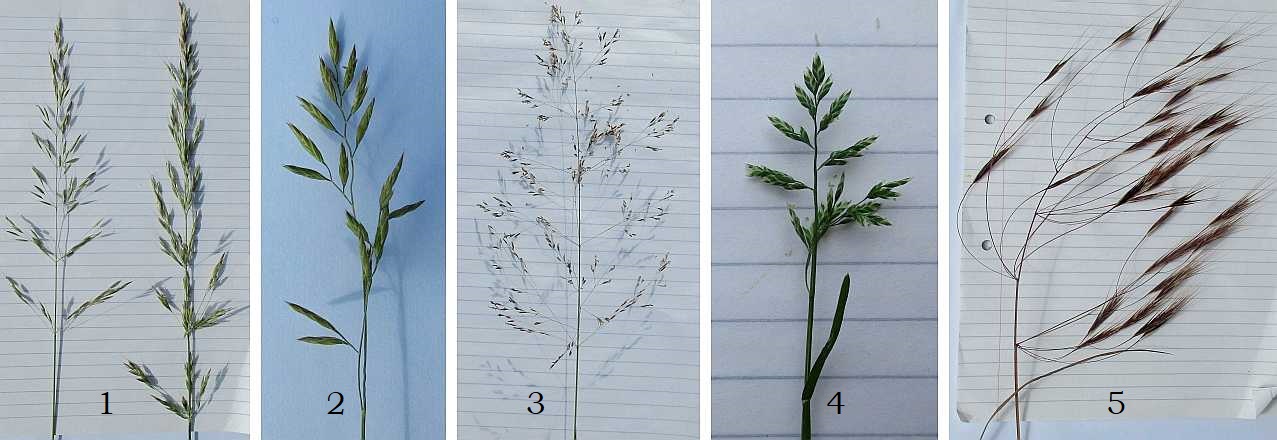MILL GREEN NATURE RESERVE
CANNOCK
FLOWERS
listed by colour and then by time of year.WHITE or very pale :: YELLOW :: BLUE :: MAUVE :: RED or PINK or ORANGE :: GREEN or BROWN :: GRASSES
Some forest tree flowers are included on the Trees page.
WHITE
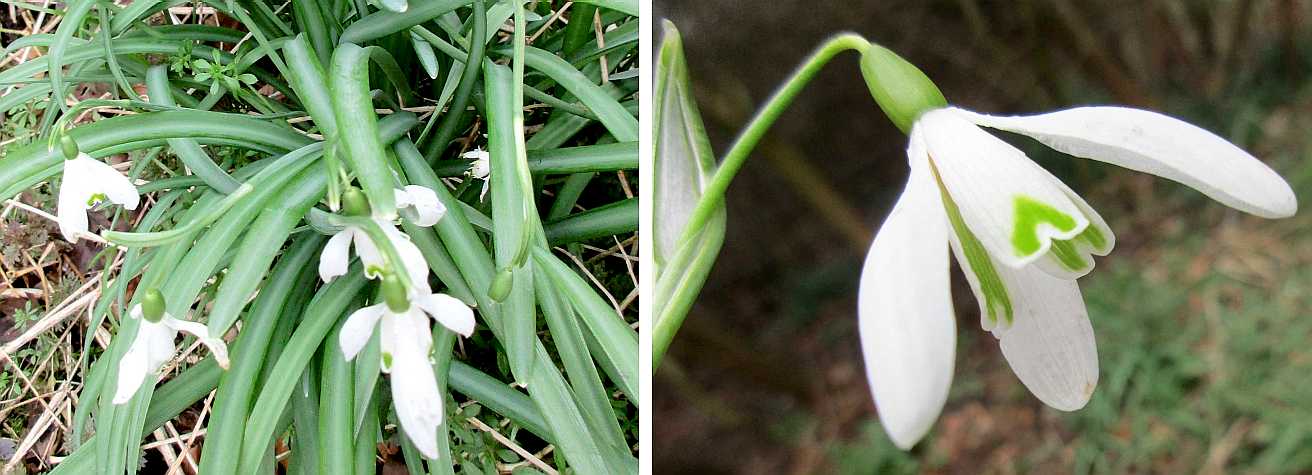 |
Snowdrop Needing no introduction, snowdrops are usually the welcome first sign that winter will be ending soon. Photographed in March (rather late in the snowdrop season). Galanthus nivalis |
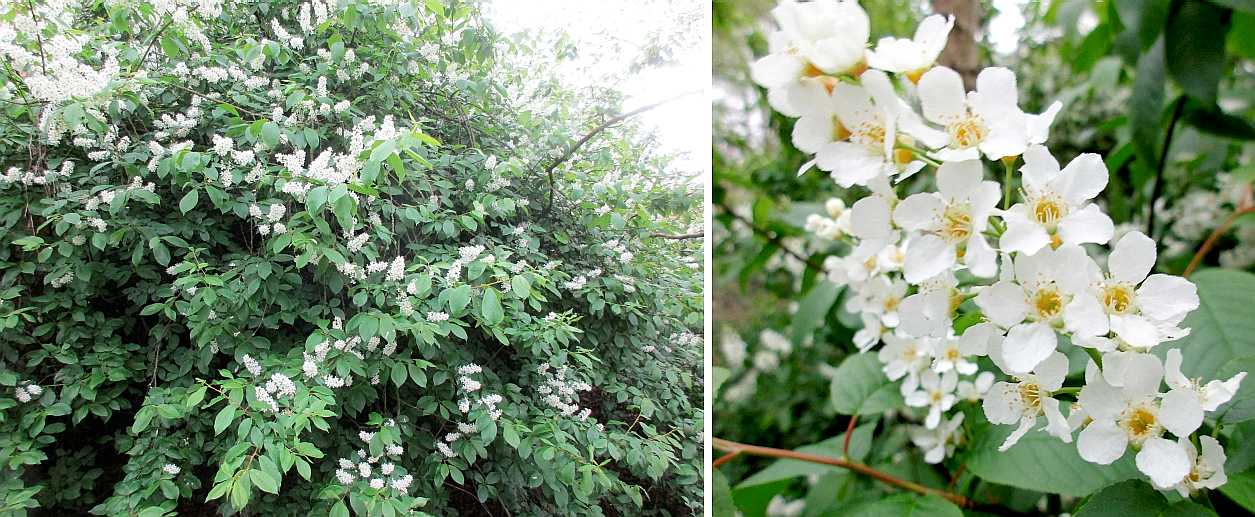 |
Bird cherry There are several kinds of wild cherry trees and shrubs on the Reserve, all with white flowers, including the earliest springtime displays. This bird cherry is relatively late, but it produces a notable display. Photographed in April. Prunus padus |
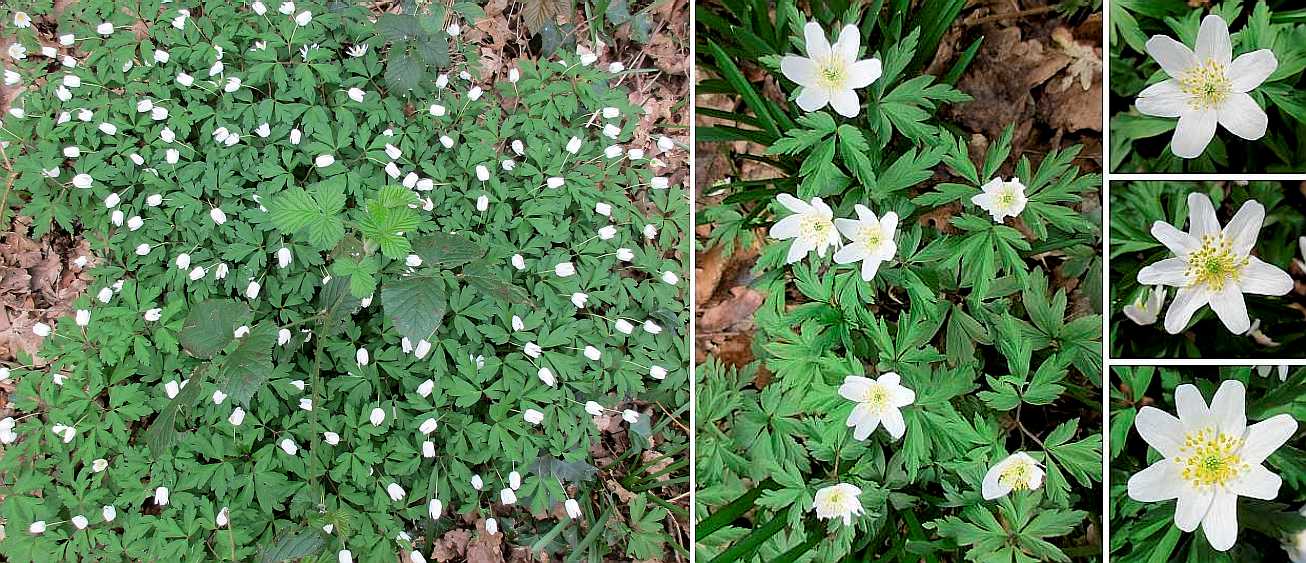 |
Wood anemone Commonly the earliest of the spring flowers in (as its name implies) woodlands including our oak tree areas. Photographed in April. Anemone nemorosa |
 |
White dead-nettle One of several kinds of non-stinging nettles. The flowers are mainly in groups up the stems rather than at the top. Photographed in April. Lamium album |
 |
Daisy This so-common 'weed' can survive cutting, mowing, treading and every kind of weather. Photographed in April. Bellis perennis |
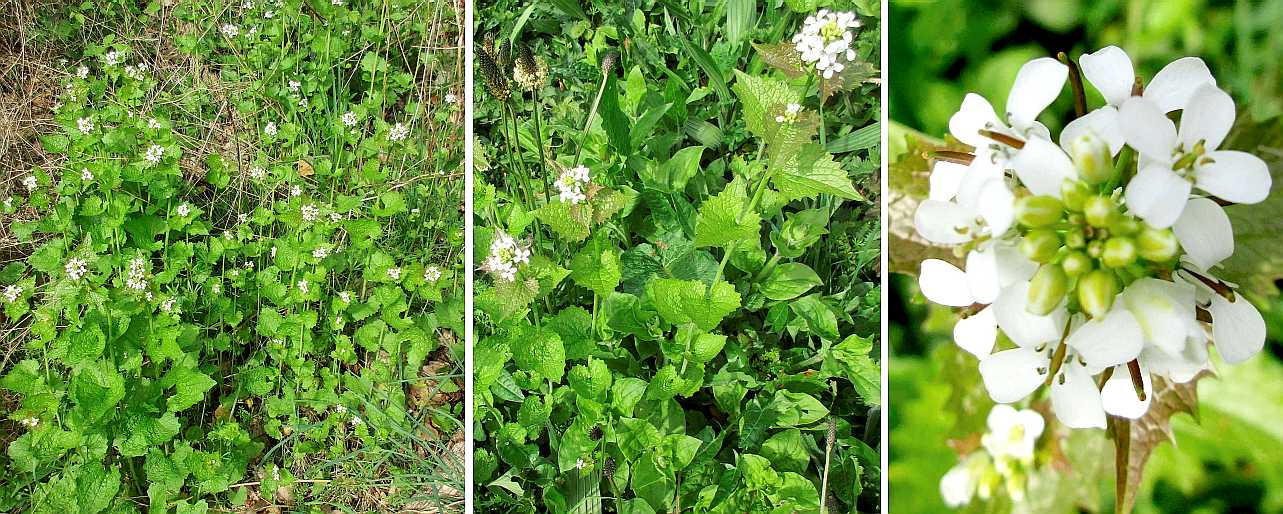 |
Garlic mustard A common contributor to the path-side flora around our Reserve. It's actually a biennial, producing only leaves in its first year, flowering and seeding in the second year. Photographed in April. Alliaria petiolata |
 |
Lady's smock When one of our Conservation paddocks is referred to as 'a flower-rich meadow' the lady's smock, almost white or very pale pink/mauve, is a major springtime contributor. It's also known as the 'cuckooflower'. Photographed in April. Cardamine pratensis |
 |
Greater stitchwort A fairly delicate-looking plant, companion to bluebells in some of our woodlands. Photographed in April. Stellaria holostea |
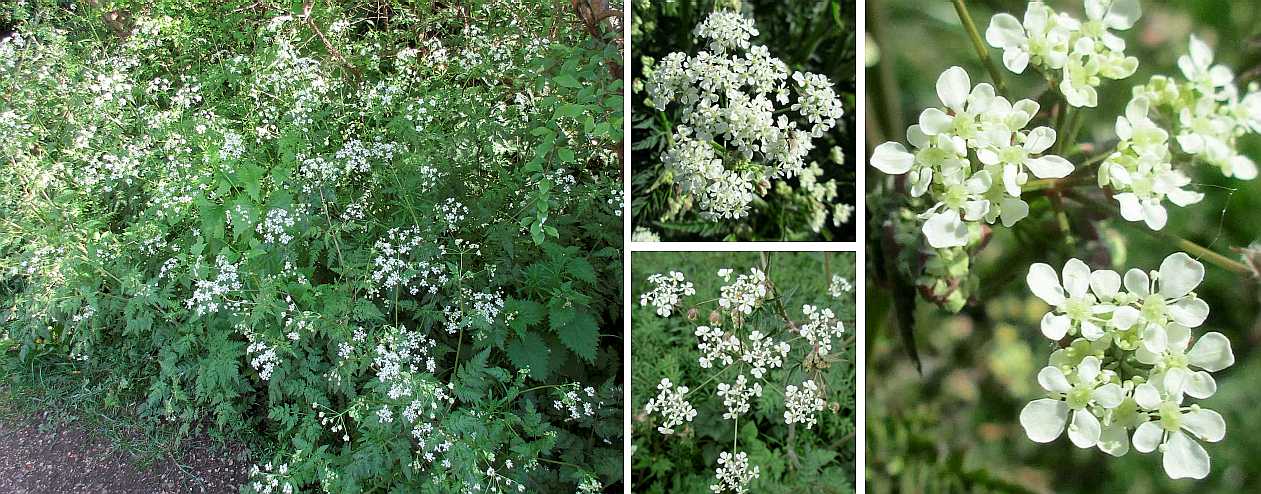 |
Cow parsley Very common, on open areas and woodland edges. Cow parsley can grow as tall as a man. Photographed in May. Anthriscus sylvestris |
 |
Hawthorn A shrub, often quite tall and large. Fertilised flowers will produce haws later in the year. There are many different types. Photographed in May. Crataegus monogyna |
 |
Mountain ash or Rowan The rowan or mountain ash is a common small tree, producing a generous crop of orange berries in due season, popular with birds. Photographed in May. Sorbus aucuparia |
 |
Elder A small tree with curiously soft wood: both flowers and fruits can be harvested for winemaking! Photographed in June. Sambucus nigra |
 |
Brambles There are many slightly different kinds of brambles, even within our Reserve. Colour, size, number and shape of petals, and growth habit all vary. Photographed in June. Rubus species |
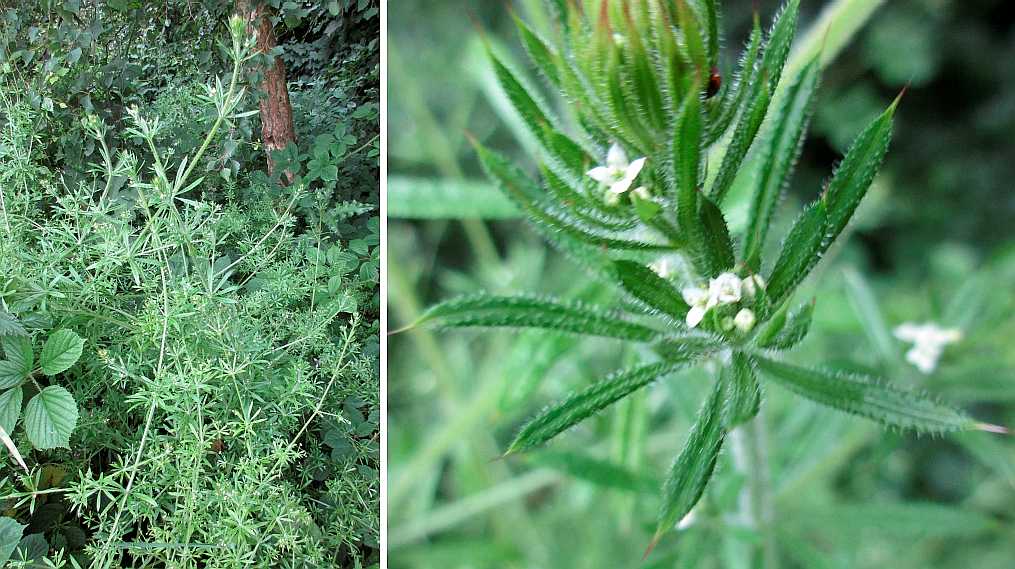 |
Cleavers This is the trailing plant that sticks to your clothes. You'd never normally notice the tiny white flowers. Photographed in June. Galium aparine |
 |
Ox-eye daisy This unmissable giant version of the lawn daisy is found in many grassy communities. Photographed in June. Leucanthemum vulgare (Chrysanthemum leucanthemum) |
 |
White clover One of the most agriculturally important plants, white clover is the basis of all productive grazing pastures. Photographed in June. Trifolium repens |
 |
Dogwood A large shrub, perhaps similar to an elder at first glance but with smoother leaf edges. Photographed in June. Cornus sanguinea (Swida sanguinea) |
 |
Dog rose Decorative but very thorny, this is the wild rose of summer. Photographed in June. Rosa canina |
 |
Hedge bedstraw Producing dense summer growth, this bedstraw is like a more-flowery version of cleavers (to which it is closely related). Photographed in June. Galium album |
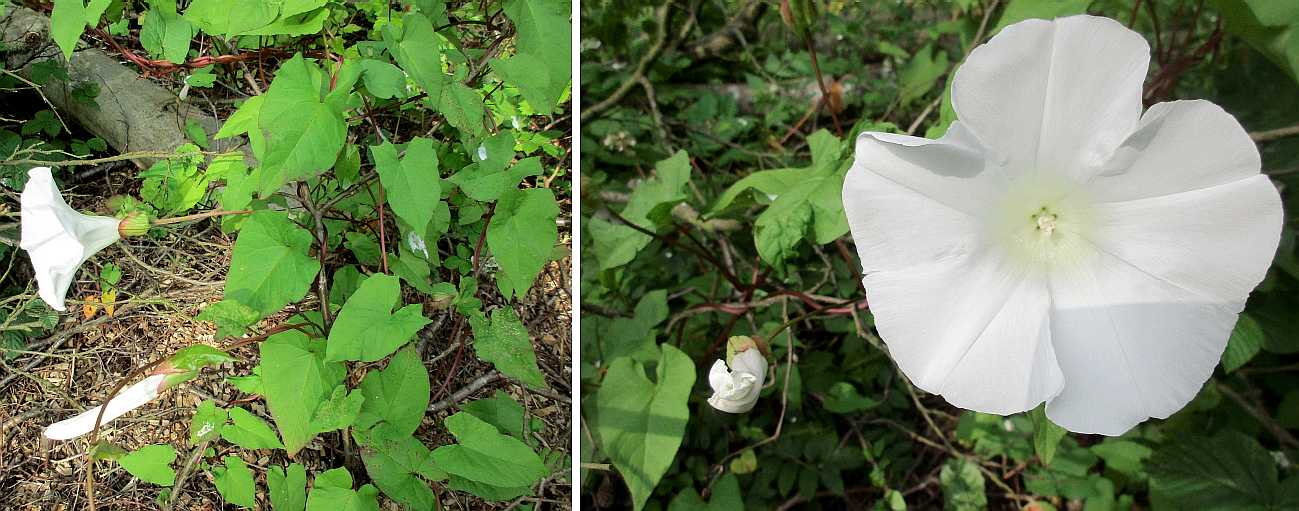 |
Bindweed This 'hedge bindweed' is the largest of several kinds of bindweeds (named '-weed' for a horticultural reason!). Photographed in June. Calystegia sepium |
 |
Meadowsweet This vigorous plant almost takes over some sections of our conservation meadow in early summer. Photographed in June. Filipendula ulmaria |
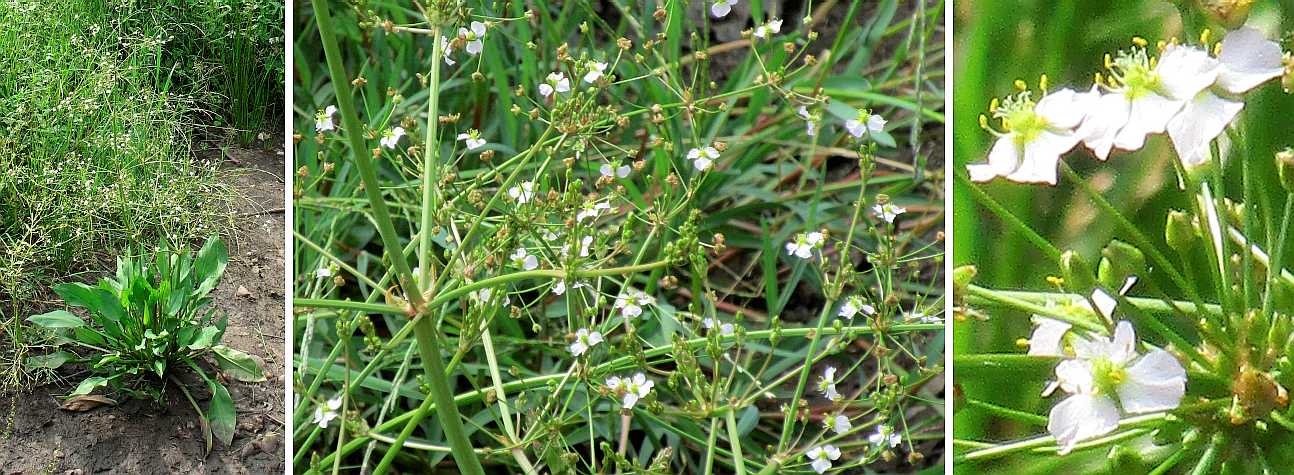 |
Water plantain A bog plant, as its name implies. It is one of the very few three-petalled flowers. (Technically, it's a monocot.) Photographed in June. Alisma plantago-aquatica |
 |
Hogweed Cow parsnip Hogweed, cow parsnip is similar to cow parsley but the heads are more rounded in shape. Not to be confused with the poisonous giant hogweed. Photographed in July. Heracleum sphondylium |
 |
Common hemp-nettle A quick-growing annual with rather modest flowers. The whole plant is hairy with, strangely, two kinds of hairs. Photographed in July. Galeopsis tetrahit |
 |
Greater burnet saxifrage There may be quite broad leaves around the base and occasional finer ones higher up the stem. Photographed in August. Pimpinella major |
 |
Knotgrass Common knotgrass A relatively minor component of the pathside vegetation. Photographed in August. Polygonum aviculare |
YELLOW
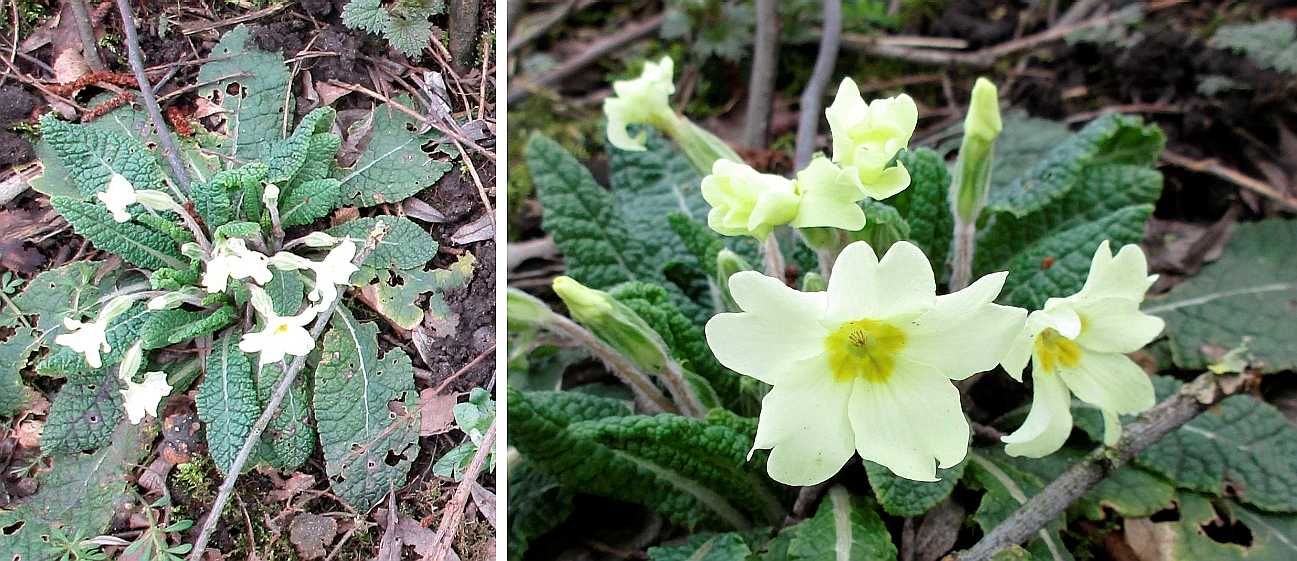 |
Primrose Primroses often provide the first colour in the late winter and early spring. Photographed in March. Primula vulgaris |
 |
Lesser celandine The lesser celandine is the first of the bright yellow ground flora to signal the arrival of spring. The petals vary in outline and curvature. Photographed in March and April. Ficaria verna |
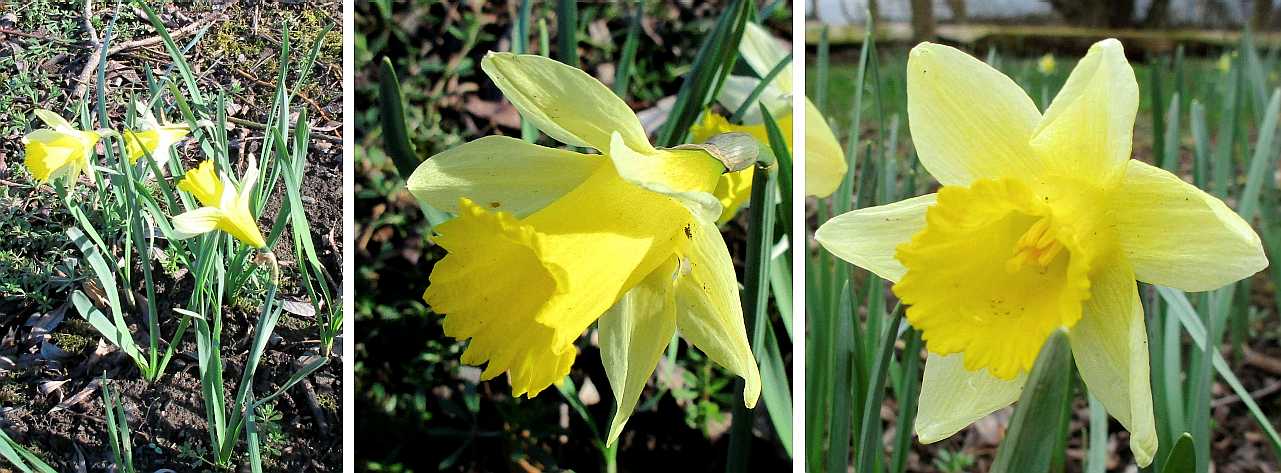 |
Daffodils / Lent lilies Although planted here by staff of the Countryside Service, these are native wild daffodils, the bulbs having been transplanted from another wild site elsewhere. Photographed in April. Narcissus pseudonarcissus |
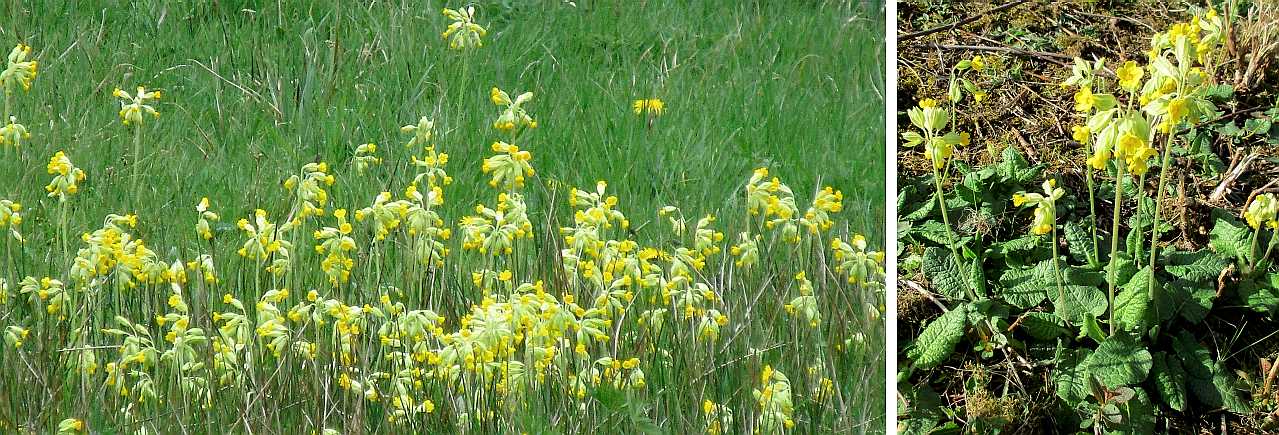 |
Cowslips The Reserve's cowslips are confined to areas within the conservation paddocks but are clearly visible from the main path. (The right-hand picture was taken while on duty.) Photographed in April. Primula veris |
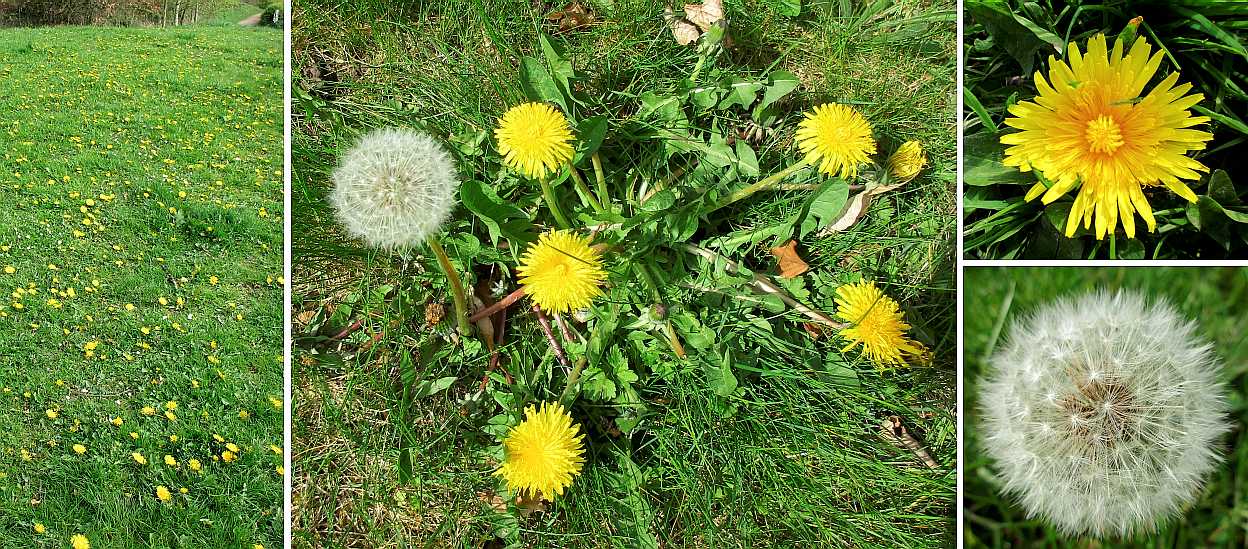 |
Dandelion An all too common lawn weed perhaps, but a gloriously colourful contributor to many countryside situations. As a member of the Compositae family (now Asteraceae), 'the' flower is made up of a compact composite assemblage of many miniature flowers, each of which produces one tasselled seed. Photographed in April. Taraxacum officinale |
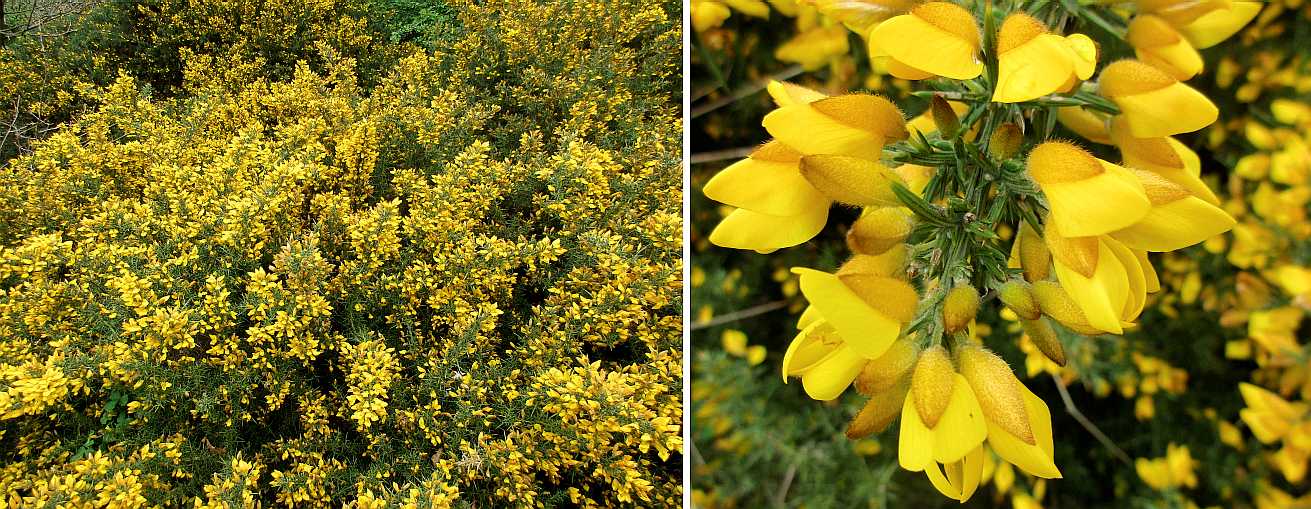 |
Gorse or Furze A very spiny shrub which can grow almost to tree height. Some flowers can be found at any time of year. It's a member of the pea, bean and clover family so it has nodules on its roots providing it with nitrogen. Photographed in April. Ulex europaeus |
 |
Creeping buttercup Famous in folklore, buttercups effectively take over as celandines decline. There are several species of buttercup: this one is the creeping buttercup. Photographed in May. Ranunculus repens |
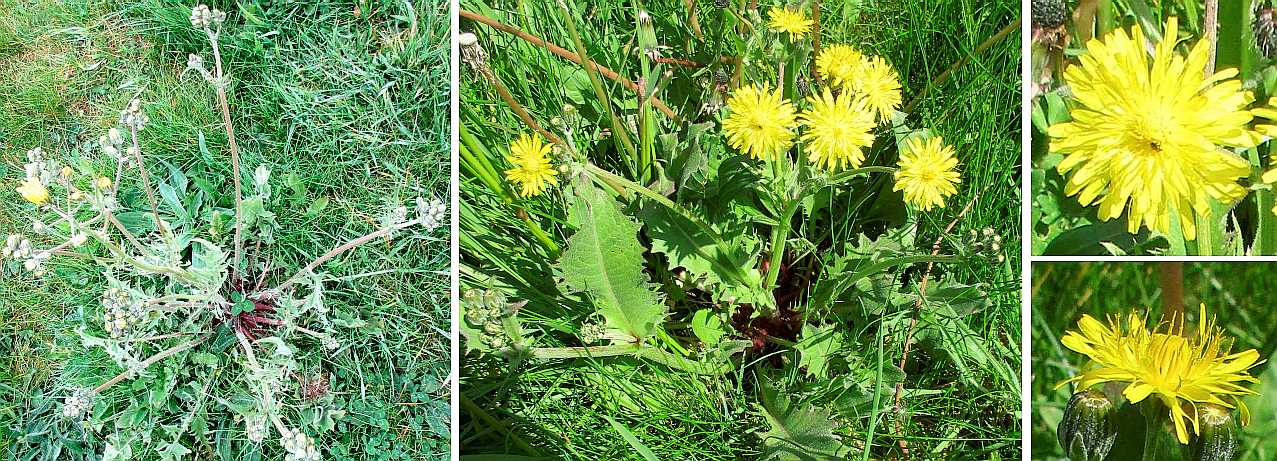 |
Common cat's ear Obviously a relative of the dandelion, cat's ear grows much taller, on branching stems. Photographed in May. Hypochoeris radicata |
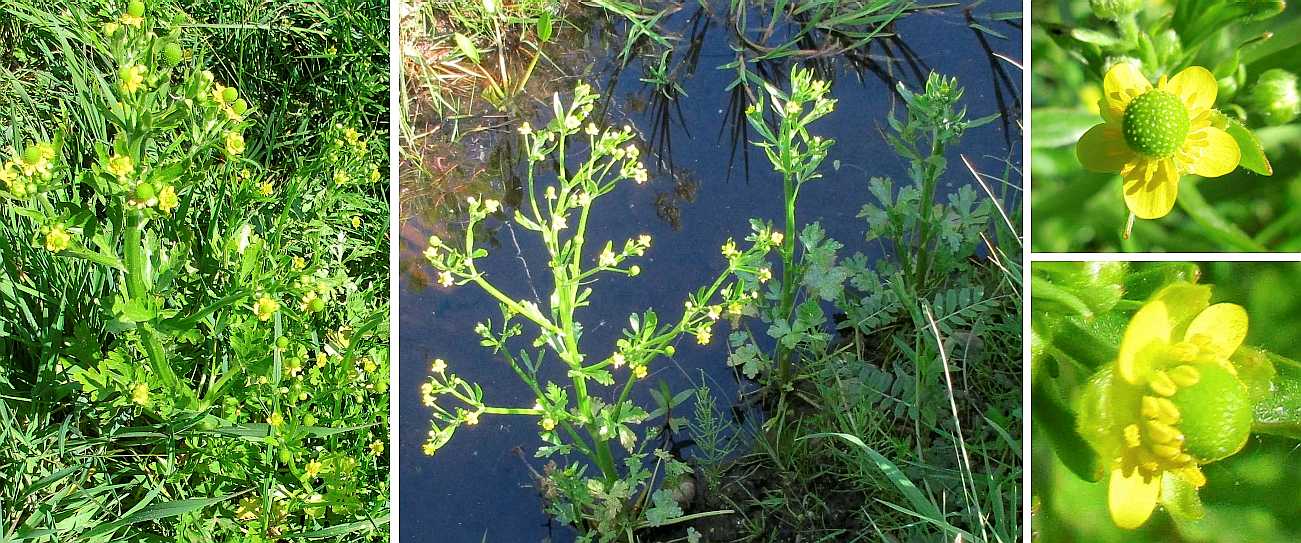 |
Celery-leaved crowfoot An annual plant (renewing itself from seed every year), this crowfoot likes boggy conditions. It's a close relative of the buttercups. Photographed in May. Ranunculus sceleratus |
 |
Common meadow buttercup The taller cousin of the creeping buttercup, this common meadow buttercup contributes massively to the May-time colour of the Reserve's conservation meadow. Photographed in May. Ranunculus acris |
 |
Wood avens or Herb Bennet The fairly modest yellow flowers will be transformed into clothes-catching burrs, helping to disperse the seeds. Photographed in May. Geum urbanum |
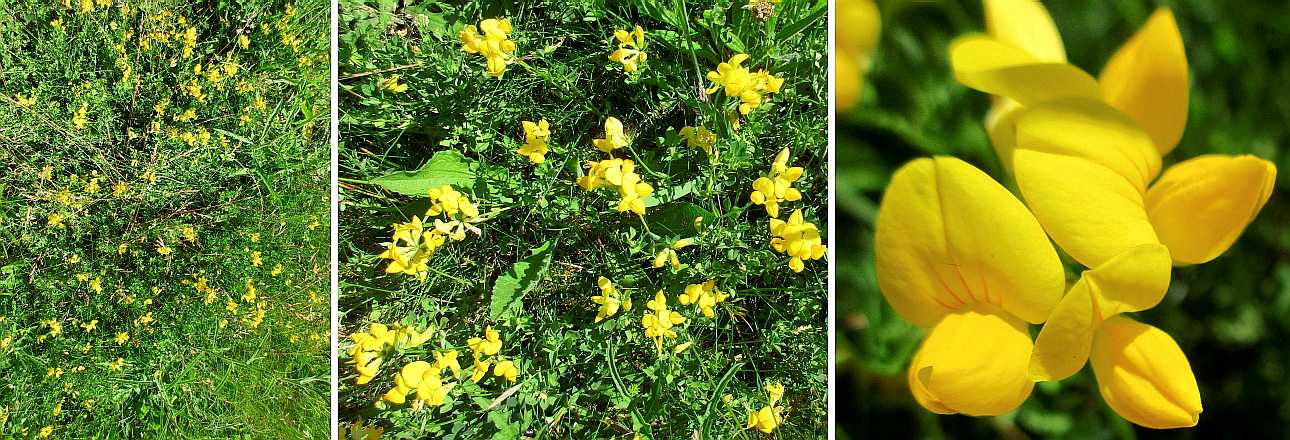 |
Bird's-foot trefoil Colourful common legume adding fertility to the soil. Photographed in June. Lotus corniculatus |
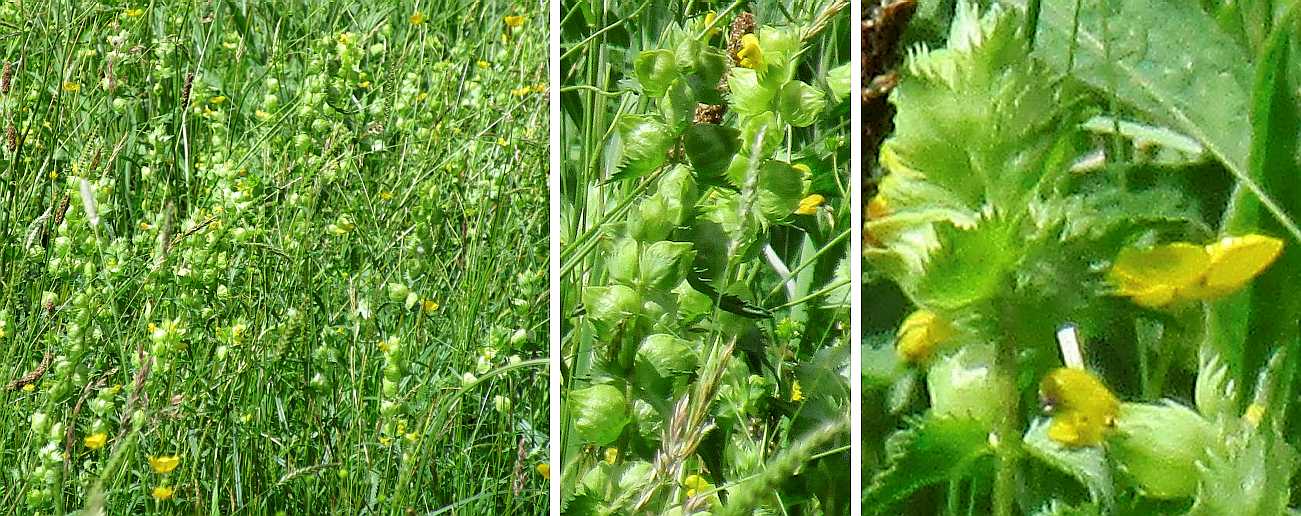 |
Hayrattle or Yellow rattle Found within the Reserve only on the conservation meadow. It is partially parasitic on grasses. Photographed in June. Rhinanthus minor |
 |
Hop trefoil Another colourful common legume adding fertility to the soil. Photographed in June. Trifolium campestre |
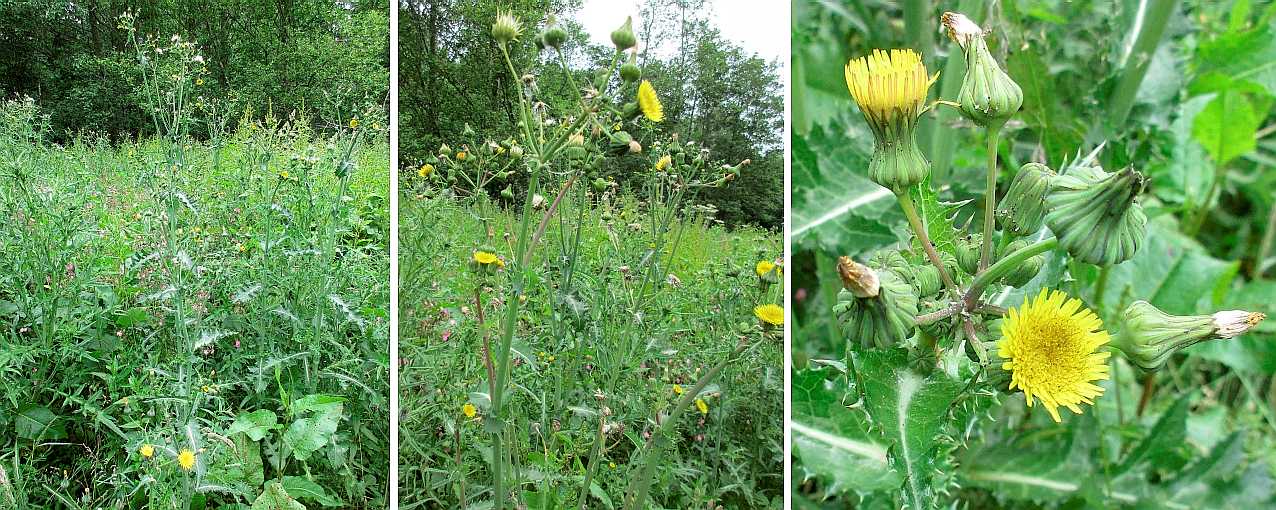 |
Sow thistle A tall and vigorous relative of the dandelion, with a strong hollow stem. Photographed in June. Sonchus oleraceus |
 |
Greater bird's-foot trefoil Marsh bird's-foot trefoil A larger and longer-stemmed version of the ordinary 'bird's-foot trefoil'. Photographed in June. Lotus pedunculatus |
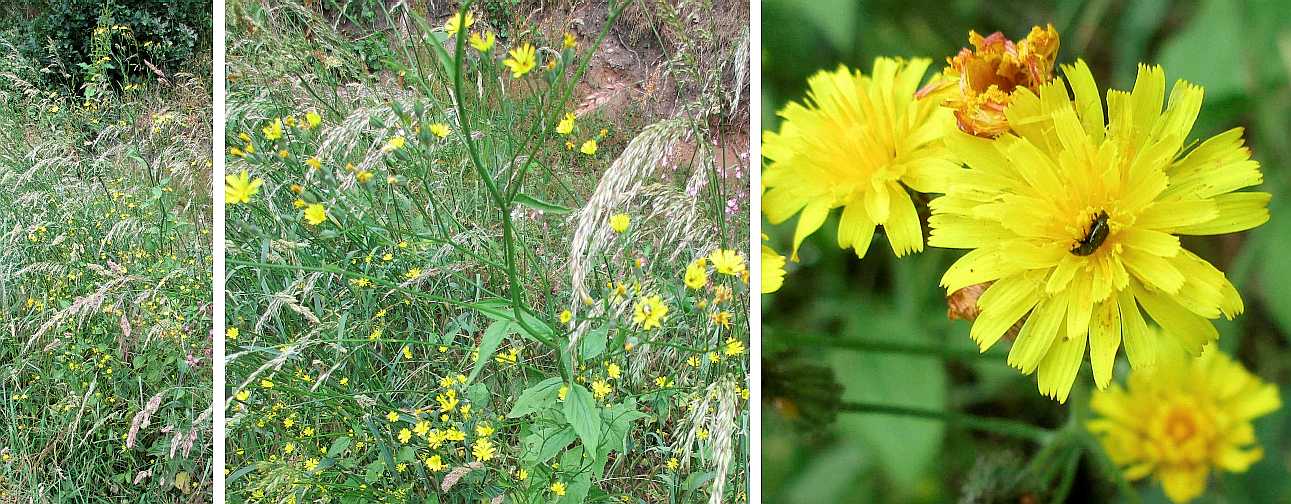 |
Hawkweed There are reported to be 260 different types of hawkweeds in Britain: it would take a specialist expert to say which species we have at Mill Green. Photographed in June. Hieracium species |
 |
Meadow pea Meadow vetchling Yellow meadow vetchling This is a legume supplying nitrogen to the soil and nectar to the pollinating insects. Photographed in June. Lathyrus pratensis |
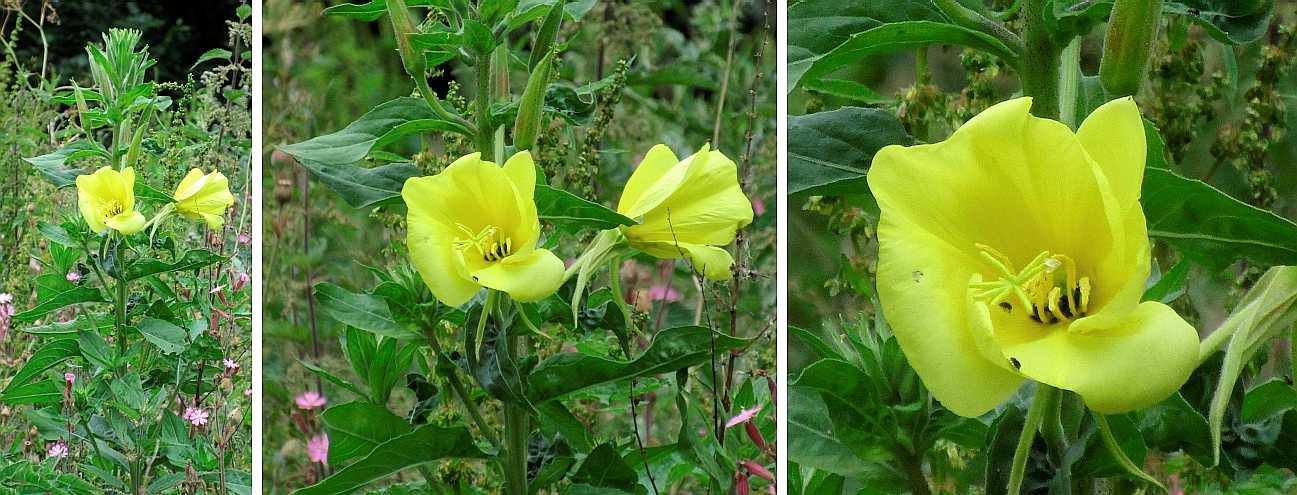 |
Common evening-primrose Large-flowered evening-primrose Immensely larger than the normal countryside primrose, this biennial is probably a garden escape. Photographed in June. Oenothera biennis Oenothera glazioviana |
 |
Ragwort Ragwort is poisonous to livestock: it is avoided when grazing but can be dangerous in hay or silage. It is an important food source for a wide range of beneficial insects, using both leaves and flowers. Photographed in July. Senecio jacobaea |
BLUE
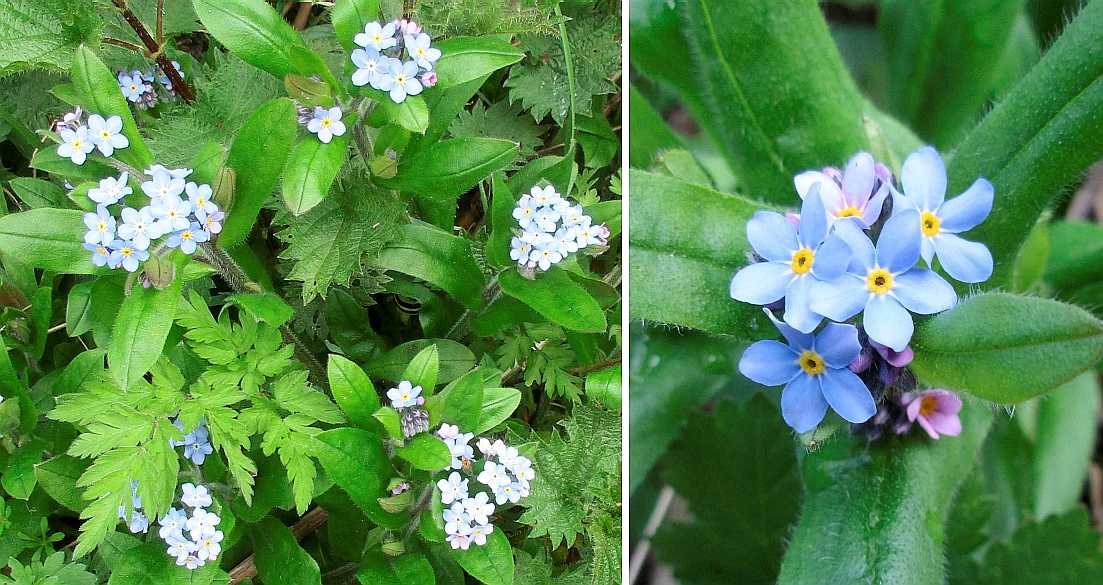 |
Forget-Me-Not A common plant, so familiar that 'forgetmenot blue' is widely recognised. Photographed in April. Myosotis arvensis |
 |
Common violet There are a few of these violet plants on our Reserve. Photographed in April. Viola riviniana |
 |
Wood speedwell The wood speedwell forms delicate clumps mainly in the oakwood areas of the Reserve. The flowers are tiny. Photographed in April. Veronica montana |
 |
Common or 'Persian' speedwell Hardly huge, the common speedwell is more substantial than the wood speedwell. It is found mainly in the mown grass areas (as a weed on home lawns too). Photographed in May. Veronica persica |
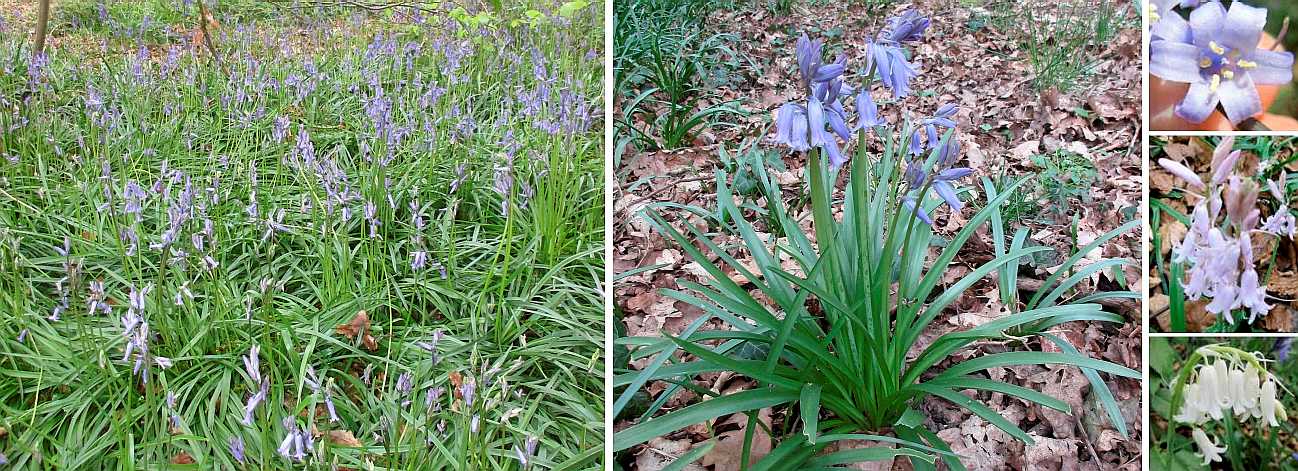 |
Bluebell Best loved perhaps en masse in springtime forests such as the Reserve oak woodland, bluebell flowers develop from over-wintering bulbs after several weeks of leaf growth. Amongst those huge numbers there may be variant forms, rarely pink, occasionally white. Photographed in May. Hyacinthoides non-scripta |
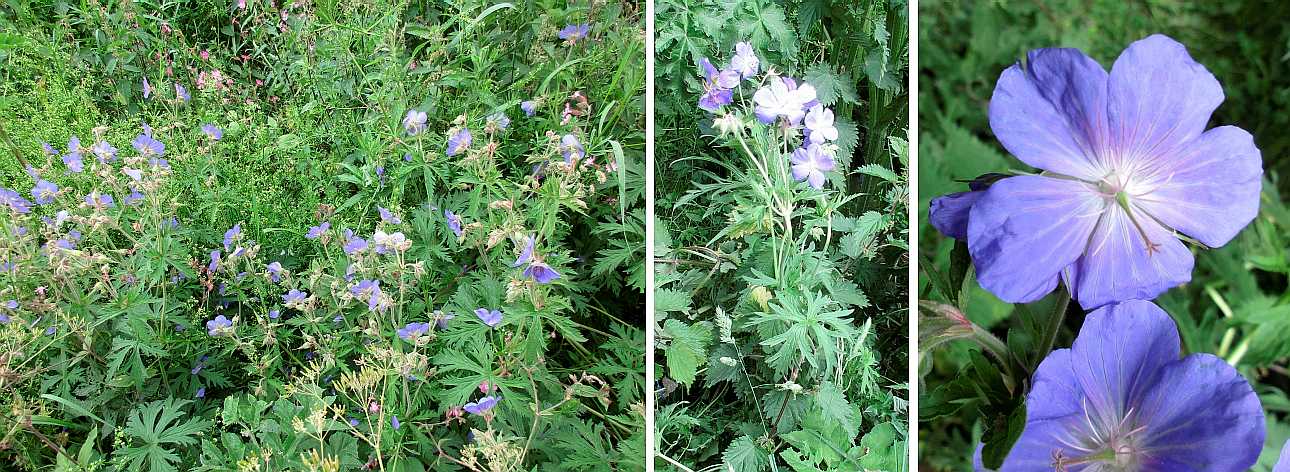 |
Meadow cranesbill This wild blue geranium is to be found mainly among the tall path-side vegetation. Photographed in June. Geranium pratense |
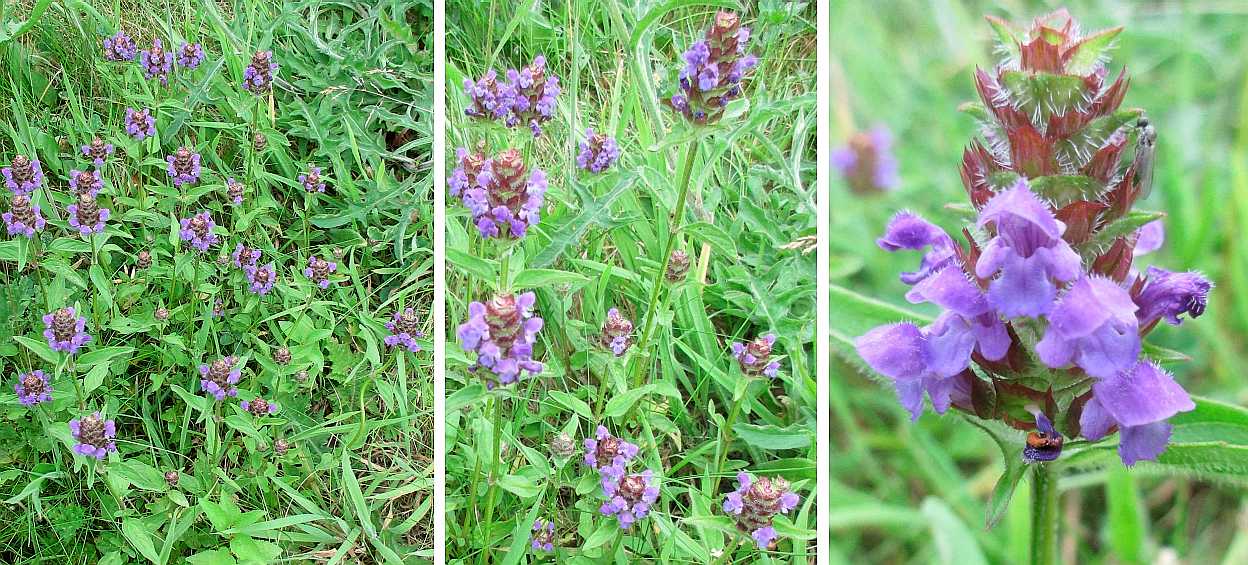 |
Self-heal A common wild flower of waste ground and woodland edges. All parts are reportedly edible, especially when young and tender. Photographed in June. Prunella vulgaris |
 |
Teasel A favourite biennial but beware prickles! Mid-line florets open first, working towards top and bottom. Dead heads can be paint-sprayed for Christmas decorations. Photographed in July. Dipsacus fullonum |
MAUVE
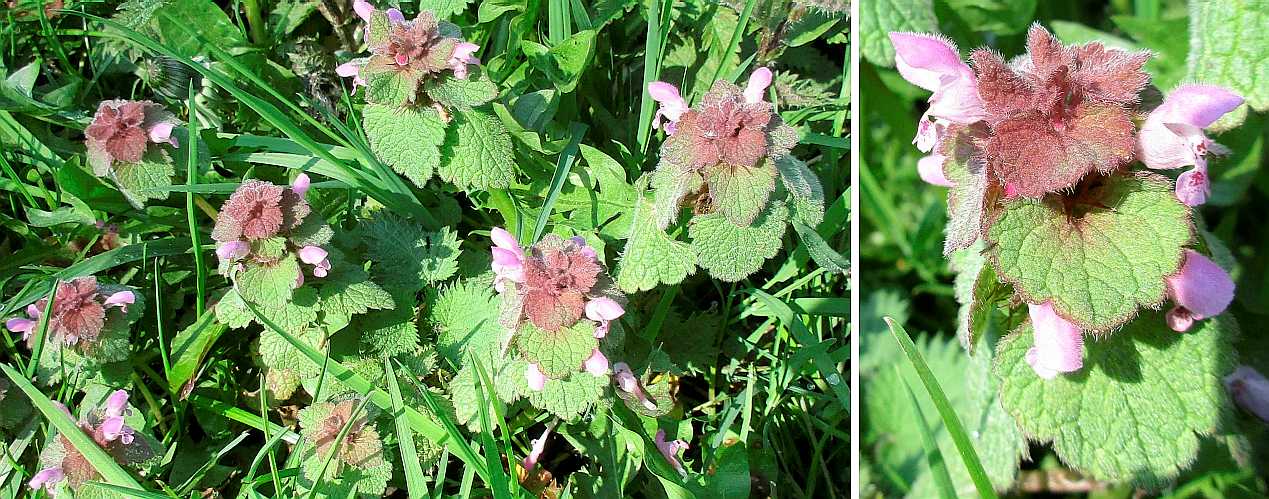 |
Red or Purple deadnettle A colourful non-stinging nettle, not usually growing very tall. Photographed in April. Lamium purpureum |
 |
Snake's head fritillary These rather special wild lilies have been decimated by UK farming systems, so these in our conservation areas are particularly welcome. Photographed in April. Fritillaria meleagris |
 |
Herb Robert Quite a common wildflower, with red hairy stems and red/mauve flowers. Photographed in April. Geranium robertianum |
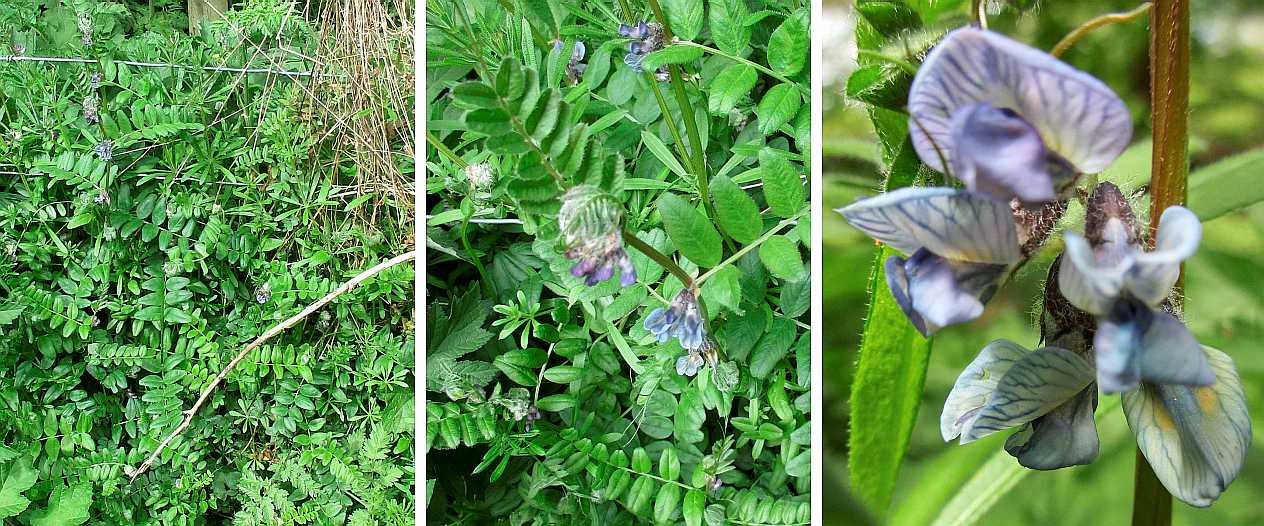 |
Bush vetch Thriving with the aid of nitrogen-fixing nodules on its roots, the bush vetch is found on many woodland and pasture edges. Photographed in May. Vicia sepium |
 |
Marsh thistle Curiously dark leaves make this thistle easily identifiable all year round. It is a rich source of summer nectar. Photographed in June. Cirsium palustre |
 |
Orchids Nearly all of our Mill Green orchids are confined to the conservation meadow and are difficult to photograph. However, on the left is a bee orchid: smaller pictures are probably three of the 'common spotted orchid' and two of the 'southern marsh orchid'. Photographed in June. Ophrys apifera Dactylorhiza fuchsii Dactylorhiza praetermissa |
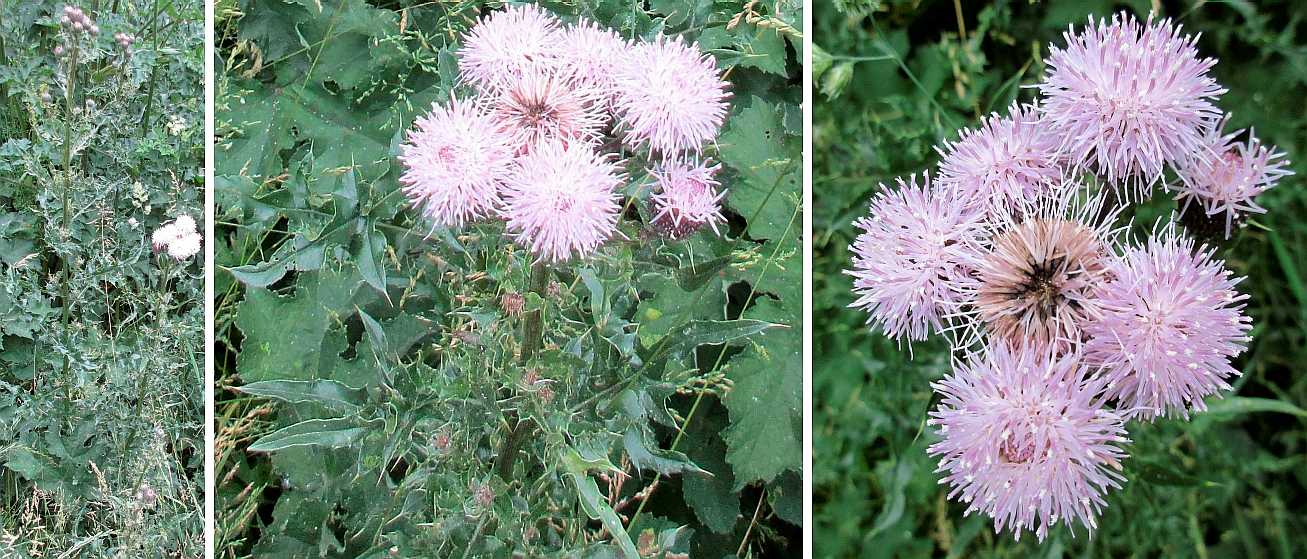 |
Spear thistle One of the very common thistles of roadsides and rough vegetation. Photographed in June. Cirsium vulgare |
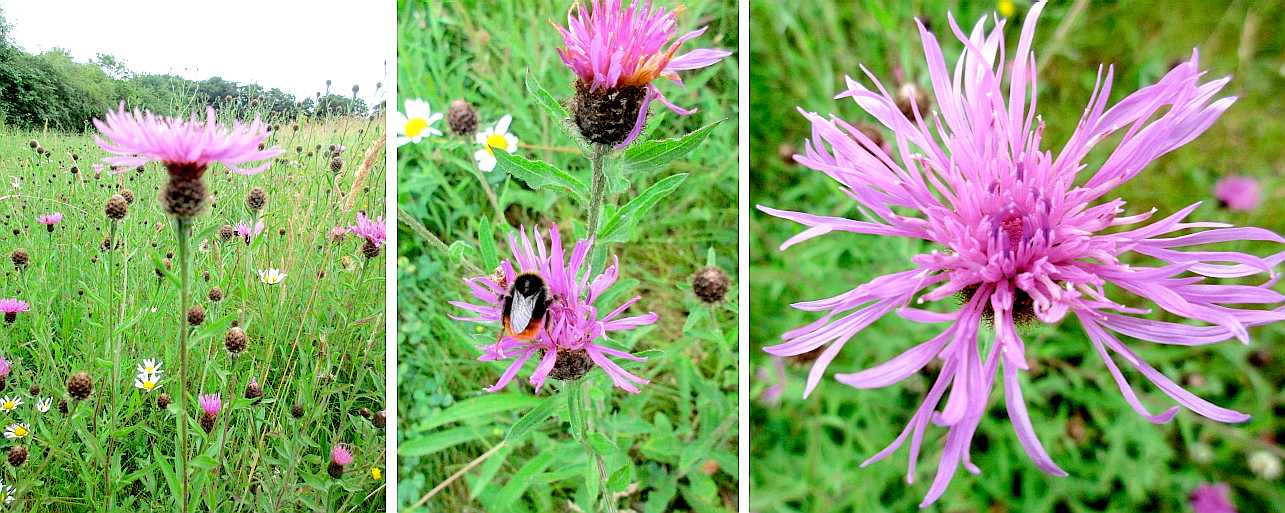 |
Knapweed Patches of knapweed with its dark coloured heads occur on the sides of the dam and elsewhere. Photographed in July. Centaurea nigra |
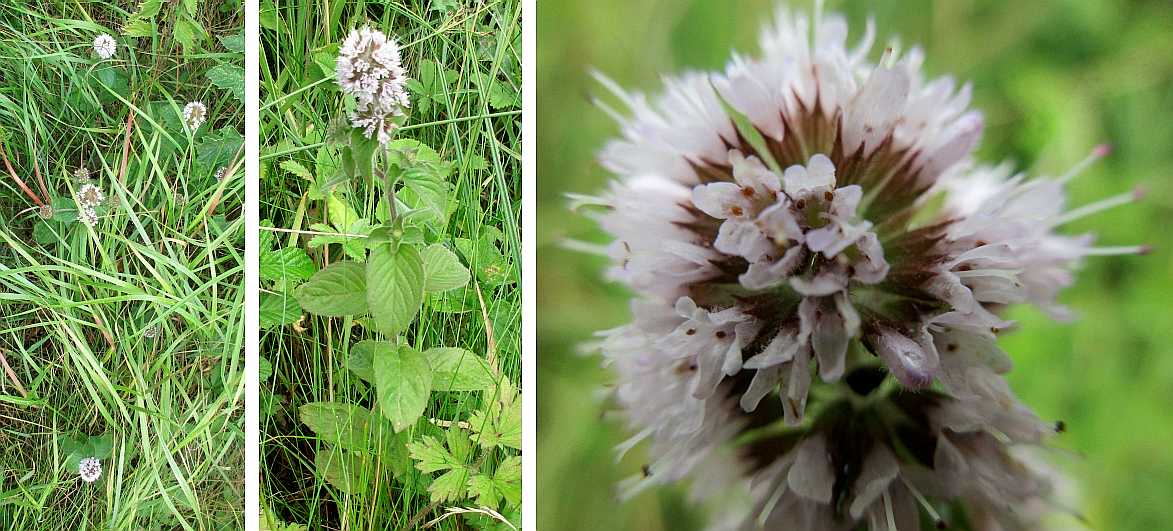 |
Water mint Nowhere dominant, this wild mint hides among the vegetation between the dam and edge of the water. Photographed in July. Mentha aquatica |
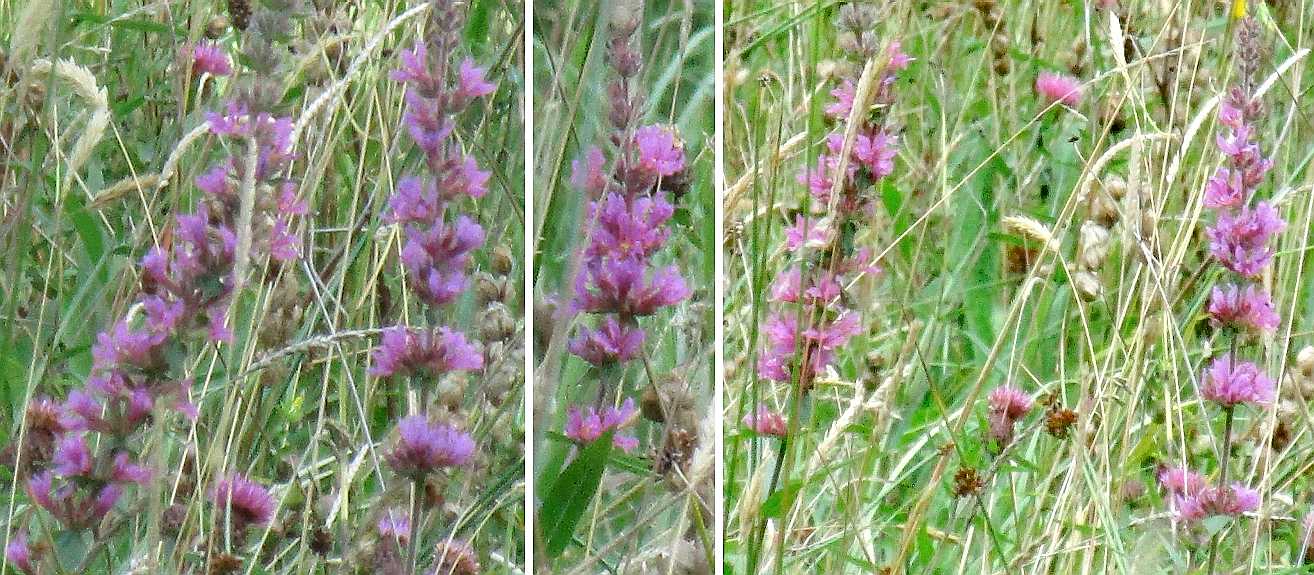 |
Purple loosestrife There are a few specimens partly visible amongst the dense vegetation in the main conservation paddock. (There are better photos online!) Photographed in August. Lythrum salicaria |
RED
 |
Red campion A common, attractive member of the ground flora. Photographed in April. Silene dioica |
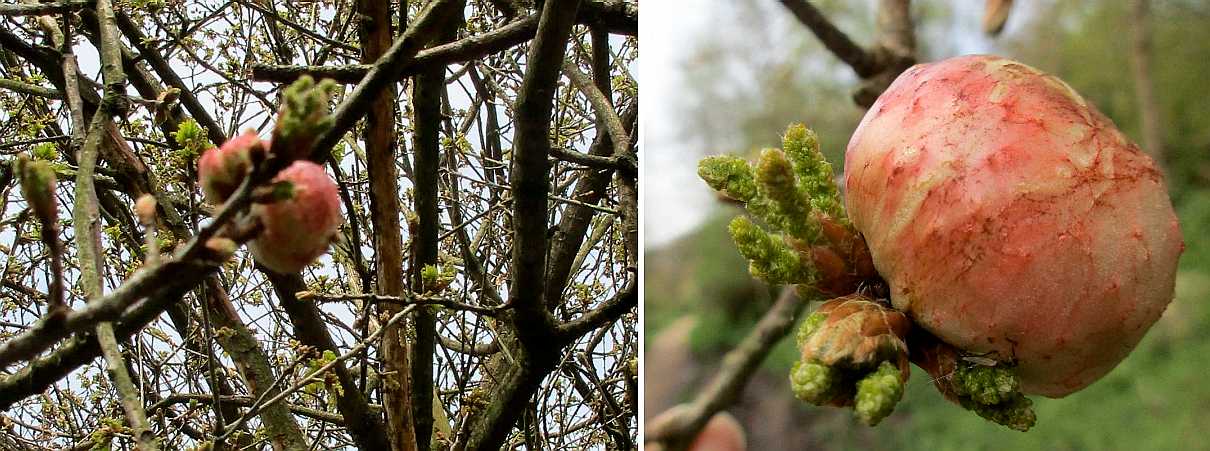 |
THIS IS NOT A FLOWER Oak apple gall When an oak gall wasp lays an egg in the leaf bud of an oak twig the tree reacts by producing this gall, an inch or more across, commonly known as an 'oak apple', in which the wasp larva feeds and develops. Photographed in April. Biorhiza pallida (wasp) |
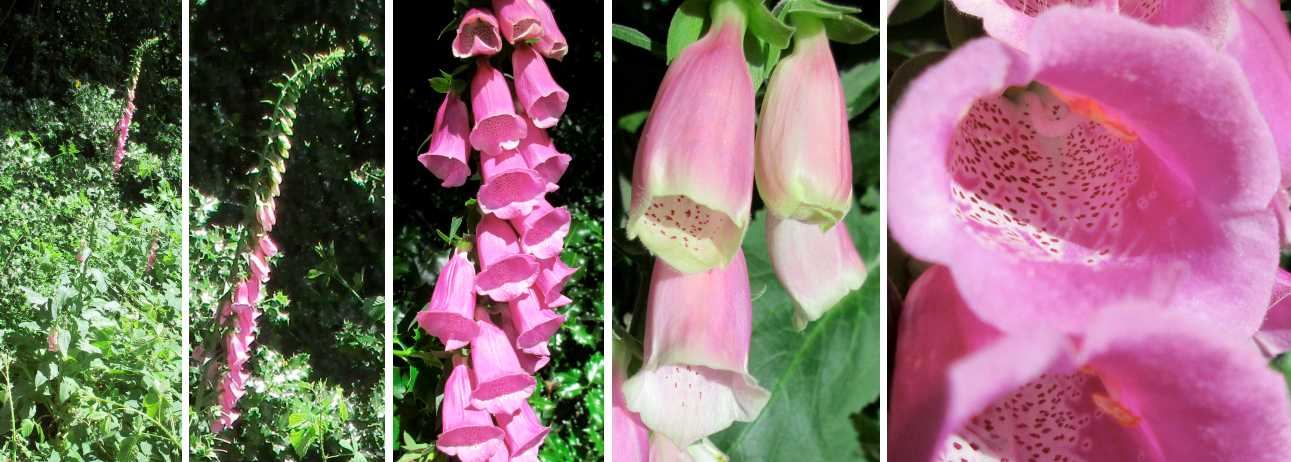 |
Foxglove Not common on our Reserve. It's a biennial, producing flowers and seed only in its second year. Its poisons have an effect on the heart. Photographed in June. Digitalis pupurea |
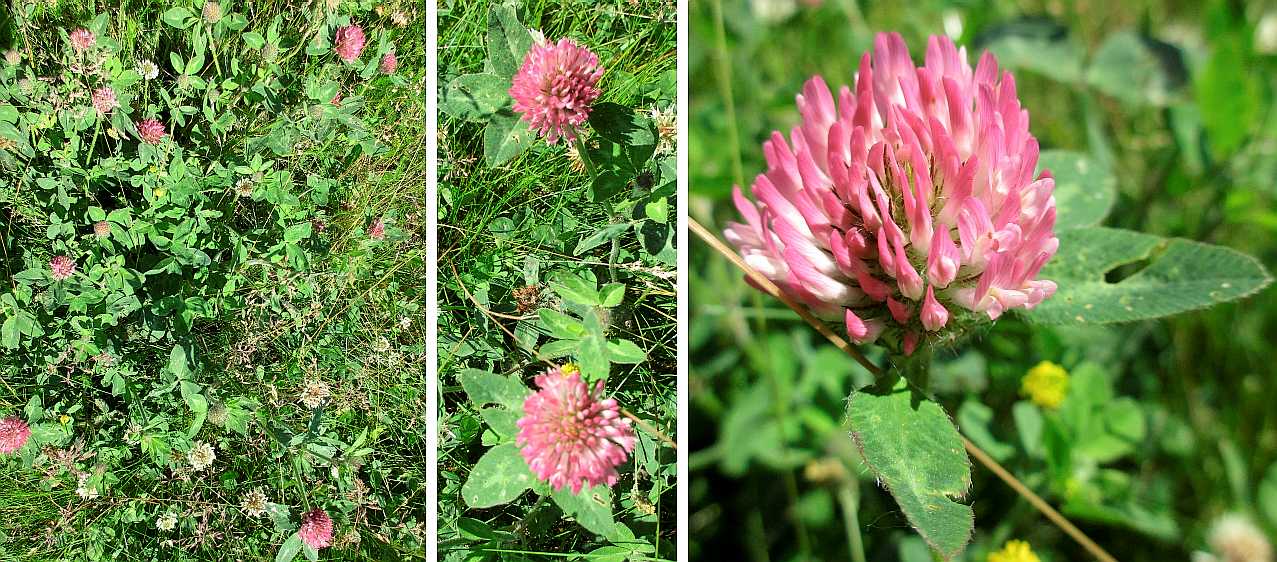 |
Red clover An agriculturally important 'hay-making' legume. Flowers can be found at almost any time of year. Photographed in June. Trifolium pratense |
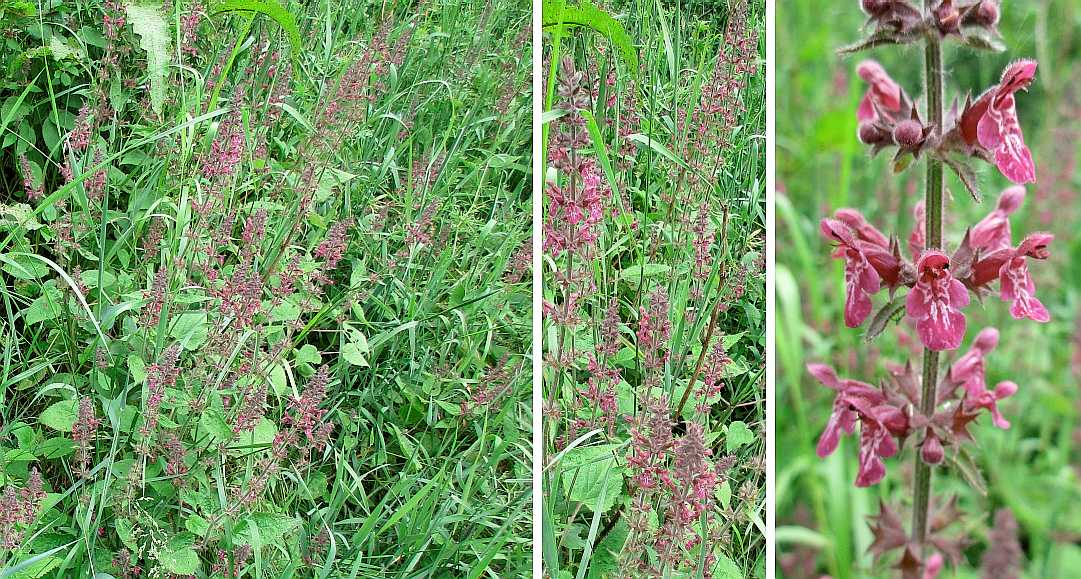 |
Wood (or hedge) woundwort Square stems and almost orchid-like flowers combine with rather dark colours on this wayside plant. Photographed in June. Stachys sylvatica |
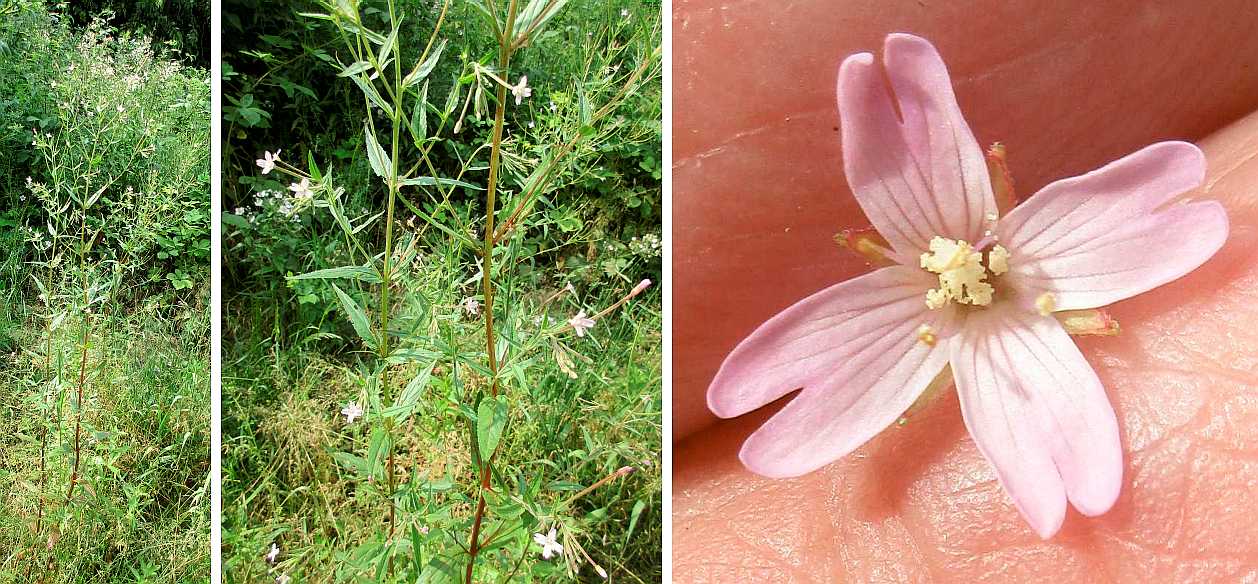 |
Broad-leaved willowherb In fact the slimmest and earliest of the three 'willowherbs' that feature abundantly on our Reserve. Photographed in June. Epilobium montanum |
 |
Orange hawkweed Fox-and-cubs A noticeable inclusion in any of our grass-based summer floral communities, with its characteristic flower colour. Photographed in June. Pilosella aurantiaca |
 |
Musk mallow An uncommon perennial almost lost among the tall pathside vegetation. Photographed in July. Malva moschata |
 |
Great willowherb A tall contributor to our late summer vegetation in many places around the Reserve. Photographed in July. Epilobium hirsutum |
 |
Himalayan balsam An attractive enemy! As its name implies, it's a foreign invader, originally a garden specimen. It's an annual plant but it is very free-seeding and harmfully aggressive. Photographed in August. Impatiens glandulifera |
 |
Rosebay willowherb The adjoining site had acres of this midsummer colour, but it is rare on our Reserve. Photographed in August. Epilobium angustifolium |
 |
Marsh woundwort Found mainly in the grass areas on the side of the dam. The right-hand picture also shows an orange fungal disease. Photographed in August. Stachys palustris |
GREEN or BROWN
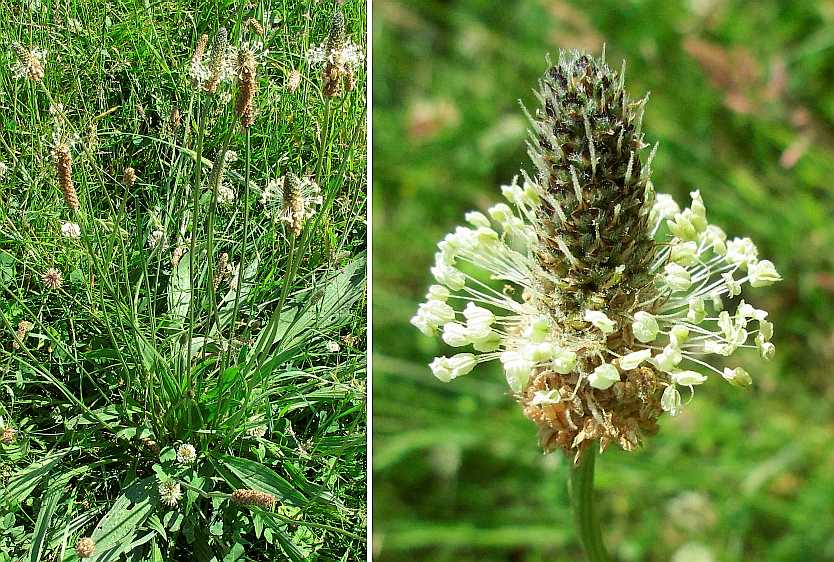 |
Ribwort plantain There are several kinds of plantain to be found in the UK: this one is known as the ribwort plantain. Despite appearances, it is only very distantly related to grasses. Photographed in April. Plantago lanceolata |
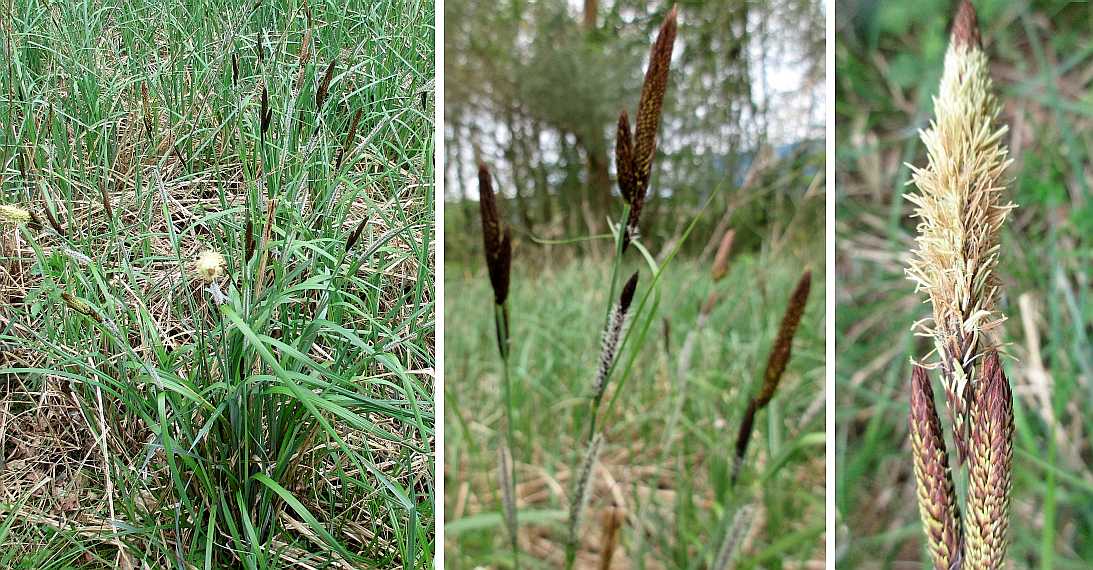 |
Common sedge Looking like a robust kind of grass, the common sedge has characteristic triangular stems. The 'inflorescences' are black when they first appear, but change colour as shown when they open up, remaining vertical or drooping down. Photographed in April. Carex nigra |
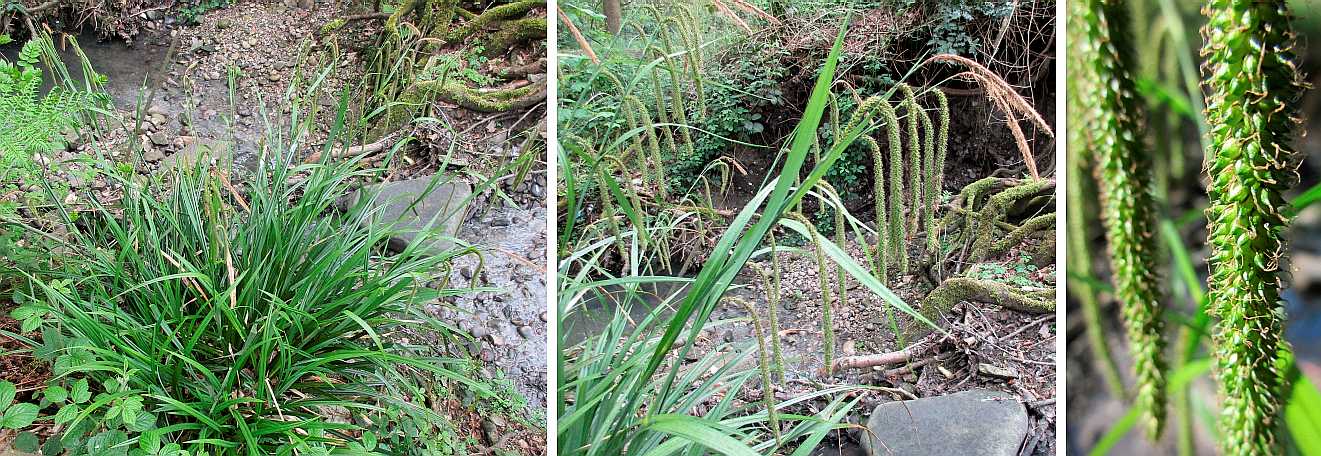 |
Pendulous sedge Located at the side of one of the minor brooks, this coarse grass-like plant is in fact another sedge. Photographed in May. Carex pendula |
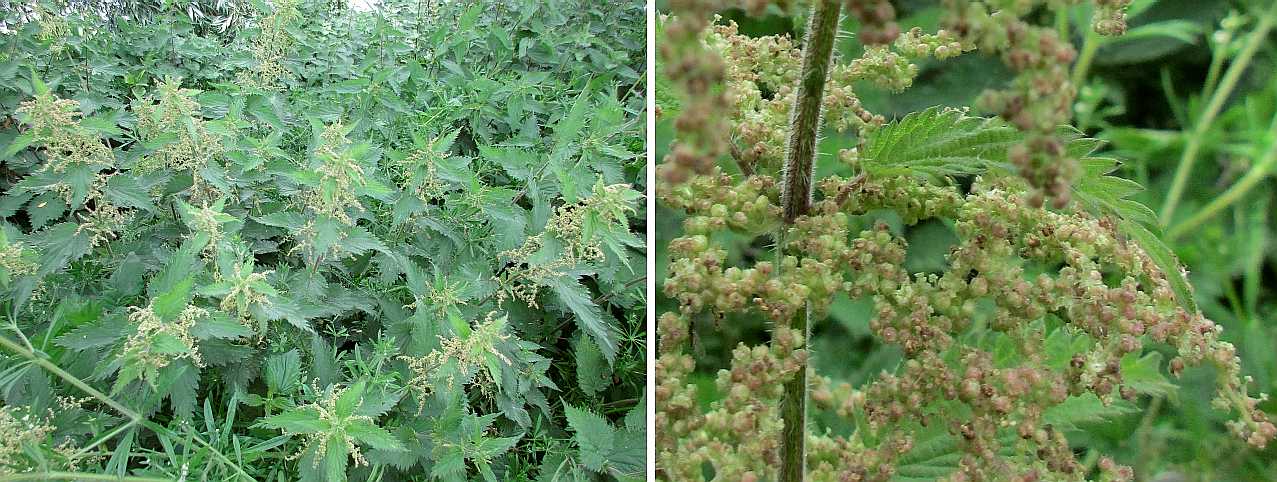 |
Stinging nettle Unwelcome to us perhaps, but a food plant for several common types of butterfly. Photographed in June. Urtica dioica |
 |
Dock There are several kinds of dock including 'broad-leaved' and 'curled' (this one): none have decorative flowers with coloured petals. Photographed in June. Rumex crispus |
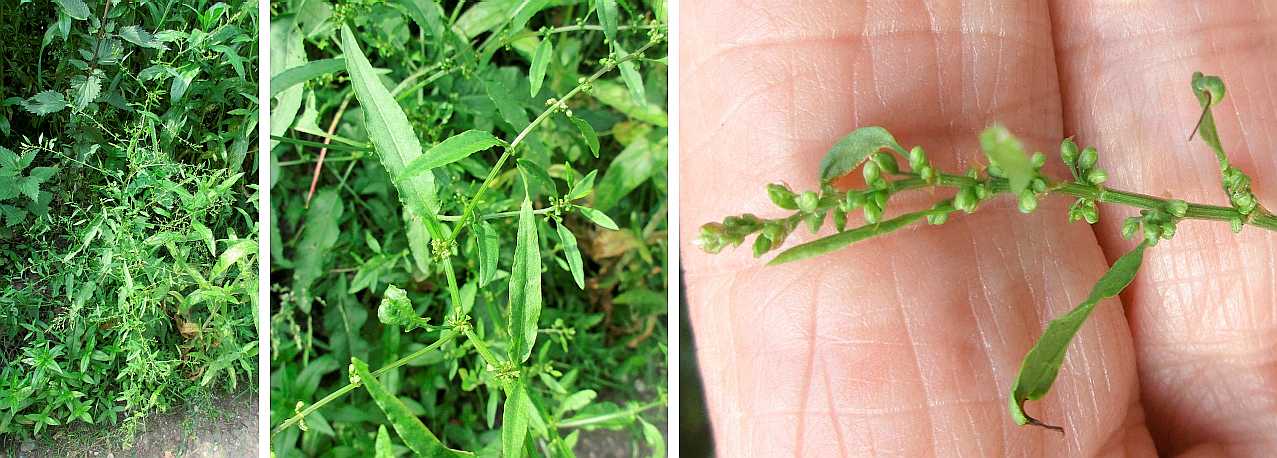 |
Long-leaved dock This is another 'dock' or 'sorrel' belonging to the genus Rumex, this one with noticeably long, tapered leaves. Photographed in June. Rumex longifolius |
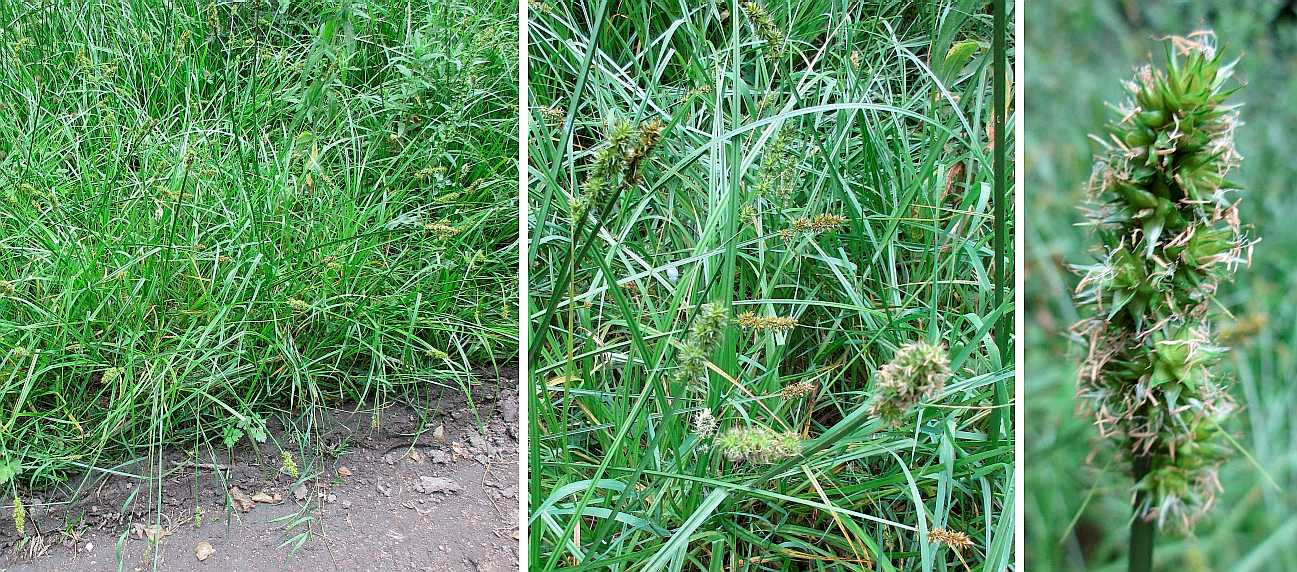 |
Sedge species This is one of the world's many thousands of different sedges: two others of Mill Green's species are detailed above. Photographed in June. Carex species |
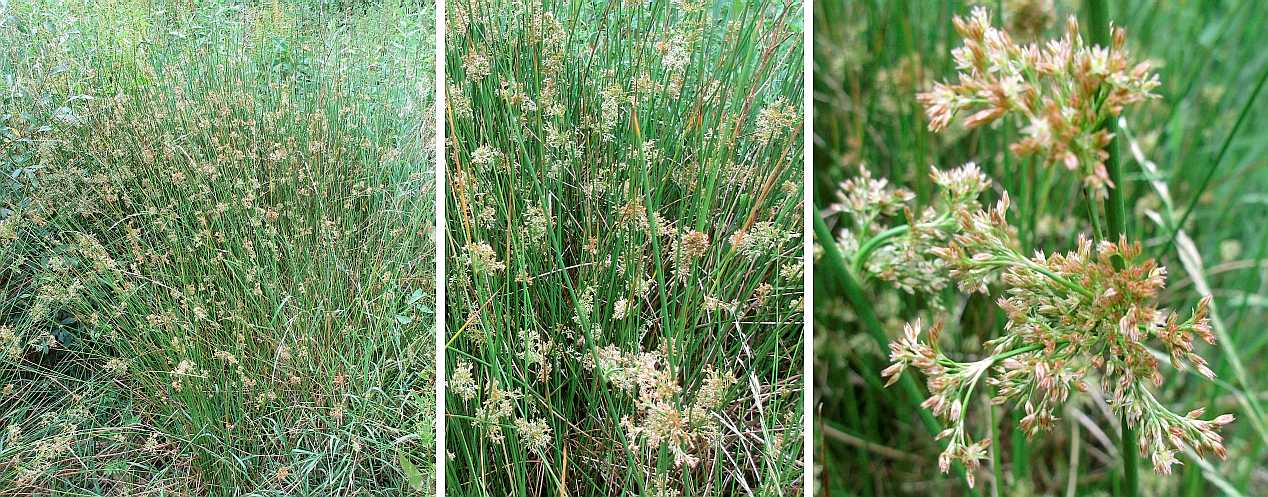 |
Soft rush An undramatic contributor on some of the wetter parts of our Reserve. Photographed in June. Juncus effusus |
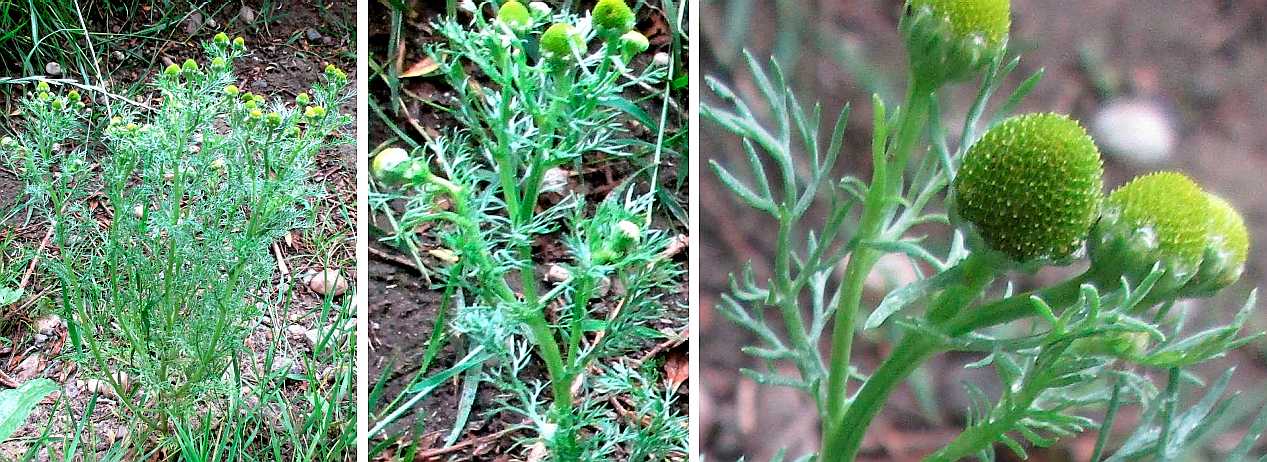 |
Mayweed or Pineappleweed or Wild chamomile A distinctive but very minor contributor to our summer vegetation along path-sides. (Wikipedia lists nine Latin names.) Photographed in July. Matricaria discoidea Matricaria matricaroides Chamomilla suaveolens |
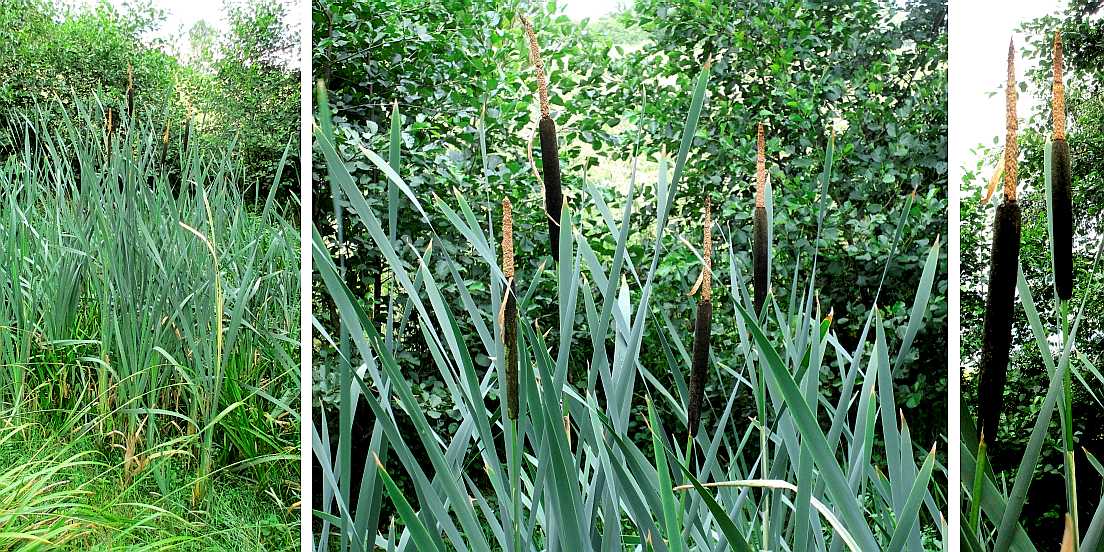 |
Bulrush Reedmace A bog plant. The big area of bulrushes is inaccessible, on the duck-feeding side of the lake. But there are enough of them to hide a moses basket by the picnic table near the car park. The tatty top bits of the spikes are male, the soft brown velvety cylinders female. Photographed in July. Typha latifolia |
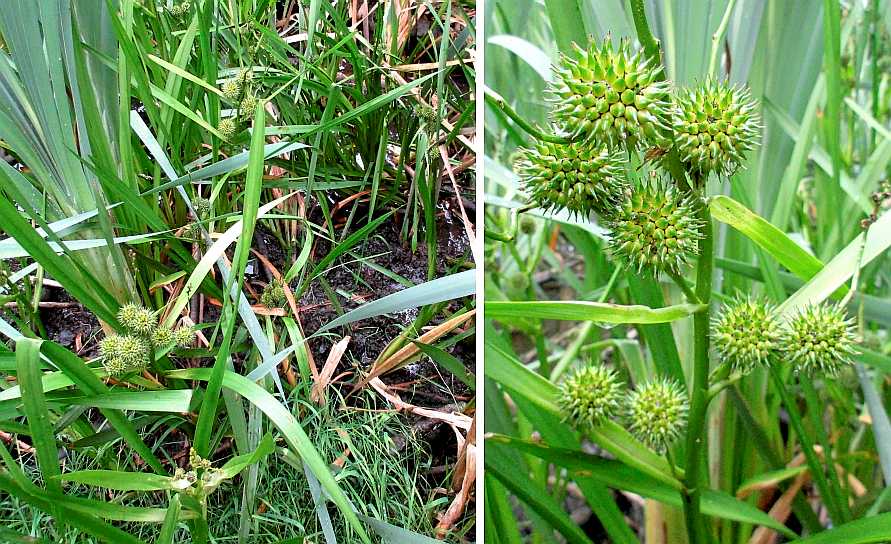 |
Branched bur-reed A bulrush companion or competitor in boggy ground. It grows from underground stems, 'rhizomes'. Photographed in July. Sparganium erectum |
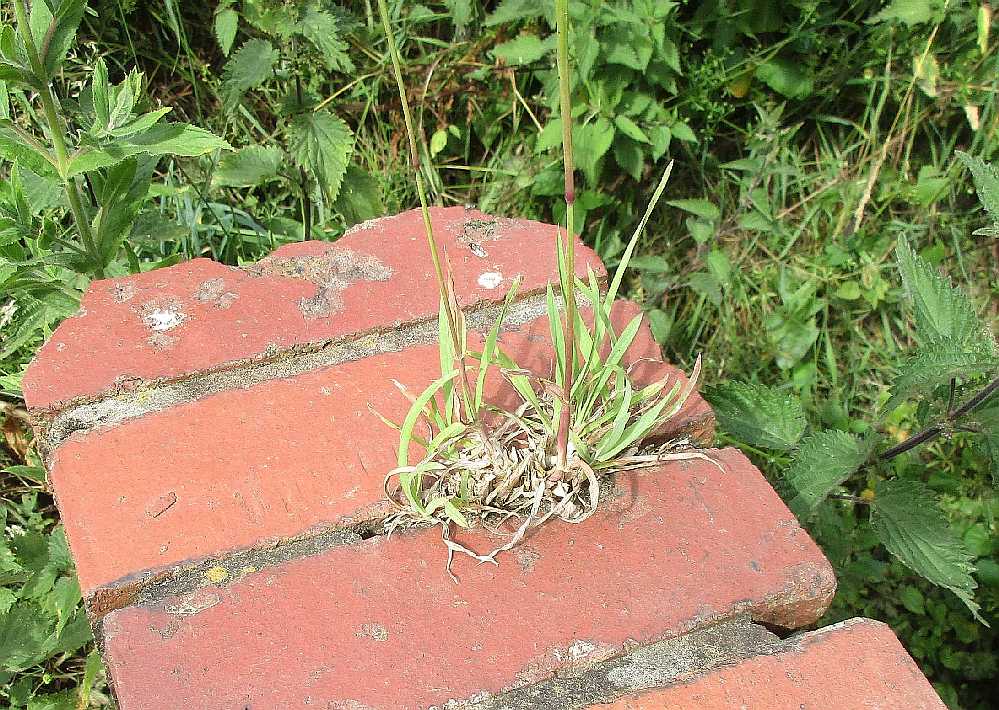 The grasses, Gramineae, make up a remarkable category of plants. They can grow almost anywhere; many can survive regular mowing in gardens and on sports pitches. There are
The grasses, Gramineae, make up a remarkable category of plants. They can grow almost anywhere; many can survive regular mowing in gardens and on sports pitches. There are 

